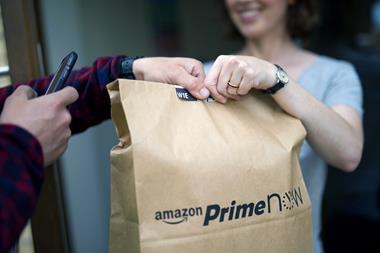The UK launch of grocery delivery service Pantry signals a shift in Amazon’s focus on the supply chain as well as customer focus.

Just in time for its yearly Black Friday recruitment period, Amazon has finally launched Prime Pantry in the UK.
Pantry is the etailer’s new platform designed to build better economics around its growing consumables business and aimed squarely at its most loyal Prime shoppers.
It creates a unique distribution strategy on the back-end which helps drive efficiencies in the supply chain. The premise of Pantry is an efficiency trade-off between incremental assortment in smaller pack sizes compared to the core amazon.co.uk platform, which is enabled by the cost efficiencies of picking and shipping a full box versus one item at a time.
Shoppers are required to build big boxes (or baskets) within the confines of a given weight and cube size
Stephen Mader
Shoppers are required to build big boxes (or baskets) within the confines of a given weight and cube size. The shopper value proposition is summarised in the tagline ‘everyday essentials in everyday sizes’.
Economical shipping
Shoppers fill their box with a number of different items from an assortment of more than 4,000 ambient items and pay £2.99 shipping fee for the box, and an additional 99p for further boxes in the same order. There are no perishables as fulfilment is via postal delivery for the time being.
This new basket building mechanism has been introduced very deliberately, as some initial confusion from Prime shoppers in having maximum thresholds to shipping is anticipated. Amazon has built filters on weight and bulk to help shoppers maximize the products they can fit into a virtual box that fills up as shoppers add more products.
On the surface, Prime Pantry signals Amazon’s continued sprint into the grocery space. It is offering an easy way to shepherd its most loyal shoppers into purchasing groceries via a stock-up mentality rather than a fill-in mentality, as well as finding a more economical way of shipping bulky/heavy consumable products.
Looking deeper however, we see some potentially huge ways that Amazon is changing its focus and its relationship with suppliers.
1. Managed profitability
Pricing on the curated assortment within Pantry is much more stable than the core Amazon platform which constantly price matches the competition. This is a huge change not only in Amazon’s pricing tactics but in the supplier relationship with buyers. Dynamic pricing and third parties on the core Amazon platform created tension with consumable forecasting and margin targets – manual pricing and removing third party listings will create something much more predictable.
2. Added complexity and costs to serve
Pantry is yet another touchpoint that suppliers must call on in addition to the core retail business and Amazon Media Group (AMG). In a reality where many suppliers’ Amazon teams are still under-resourced, this trend could have big implications on longer term resourcing requirements going into 2016. There will be an opportunity for strategic suppliers to help Amazon understand the end-to-end value chain of an Amazon.co.uk + Pantry + Prime Now relationship and where to take costs out of the supply chain.
3. Incremental distribution
The flip side of this is the potential for incremental distribution for branded manufacturers that were unable to profitably sell into the core Amazon platform. The economics of Pantry are such that listing heavy bulk products (such as carbonated soft drinks) begins to make more sense.
4. Category management light
Amazon has never fully embraced the idea of online category management, arguing (rightfully so) that at its core it is an item merchant and suppliers should instead focus on their product descriptions rather than the category. Pantry changes this slightly as the idea of themed boxes – Christmas, back to school or spring cleaning become incredibly valuable. Amazon calls these ‘box starters’ and it is a really interesting way to begin thinking about how Amazon will disrupt our traditional retail vocabulary.
- Stephen Mader, vice president of digital and retail insights, Kantar Retail


























No comments yet